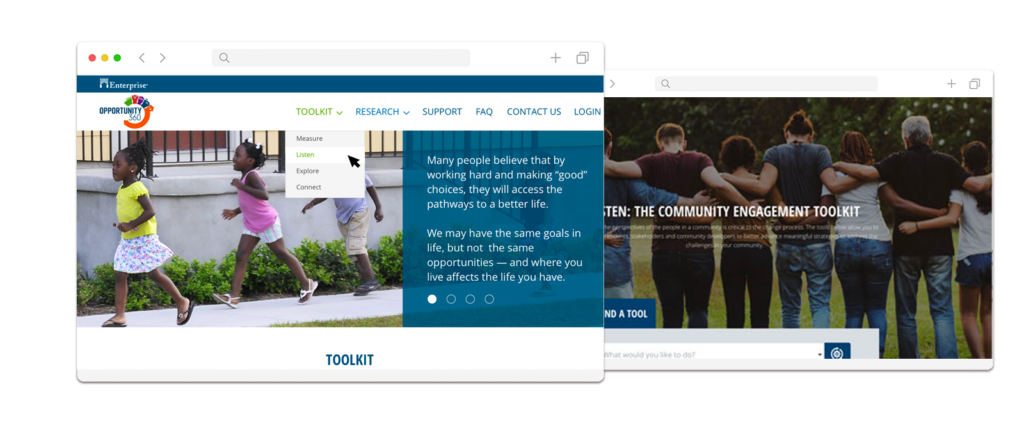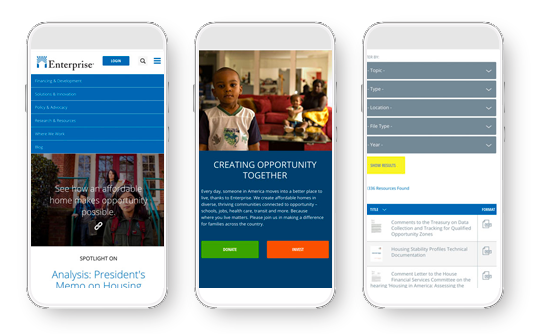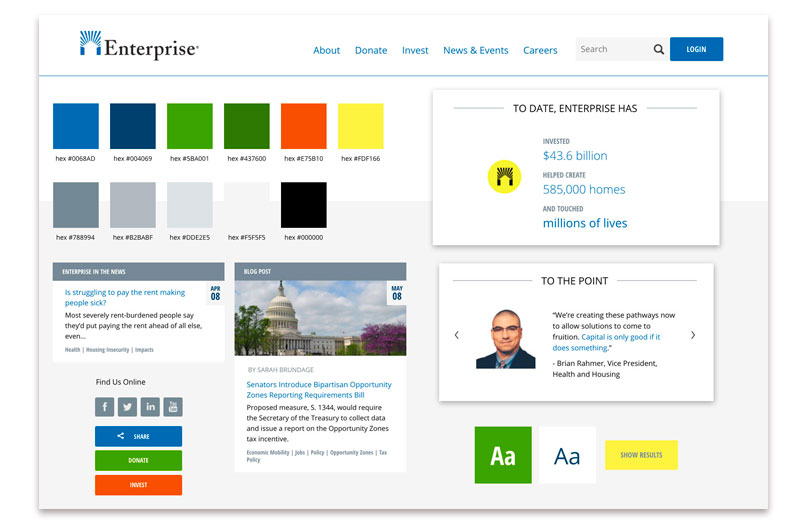Enterprise Community Partners faced challenges in managing a vast amount of fragmented content with diverse branding, requiring the implementation of a sophisticated taxonomy structure and a flexible content management system to enable dynamic and customized content displays.
Enterprise Community Partners needed to organize an enormous amount of content into a robust taxonomy structure with complex dynamic functionality to ensure a dynamic display of related content throughout the site.
Enterprise sought an easy-to-use content management system that allowed administrators to heavily customize content displays, determining which types and categories of associated content would be attached to each page.
Fíonta devised a comprehensive content strategy with various content types and a complex taxonomy to facilitate dynamic content displays. Fíonta designed a responsive Drupal 8 website with distinctly branded template options for the nonprofit and for-profit arms of the Enterprise. Custom features were implemented to dynamically display associated content, including blogs, resources, events, and people.
Flexible templates using Layout Builder featured pseudo-microsites for unique campaigns and resources. Solr site search and Google Tag Manager were integrated for enhanced search and tracking capabilities, while Okta SSO streamlined logins for numerous staff content editors.

A defined content strategy with various content types and a complex taxonomy facilitated dynamic content displays and repurposing throughout the site.
The responsive Drupal 8 site offers distinctly branded template options for both the nonprofit and for-profit arms of Enterprise, ensuring a cohesive and unified user experience.
Custom features were implemented to dynamically display associated content, making related blogs, resources, events, and people easily accessible on each piece of content.
Layout Builder enabled the creation of flexible templates for pseudo-microsites within the main site, easily featuring unique campaigns and resources.
Solr site search and Google Tag Manager provided robust tracking and configurable search synonyms, enhancing administrator control of search results and audience engagement monitoring. Okta SSO facilitated quick logins for numerous staff content editors, ensuring efficient content management.
The implementation of a comprehensive content strategy with a complex taxonomy allowed for dynamic content displays and repurposing throughout the site. The responsive Drupal 8 site provided distinct template options for both nonprofit and for-profit arms, ensuring a unified user experience. Custom features, flexible microsite templates, and enhanced search capabilities improved the overall website performance, while efficient content management tools streamlined the process for staff content editors. Lastly, the new Resource Center allows users to easily find and download resources, supported by multiple filtering options and tagging.


Steering all project facets like budget, schedule, scope, and risk management while collaborating with technical leads on risk handling, our project managers serve as the primary liaison with clients, offering frequent updates on project progress.
Skilled at Drupal CMS, our developer adeptly configures, develops, and styles websites, translating designs into new functionalities with expertise in coding languages, customizing modules, and crafting custom code as needed.
Expertly navigating client websites to facilitate enhancements in line with organizational goals, emphasizing sustainable growth, versatile functionality, and simplified maintenance.
Transforming technical specifications into visually engaging web interfaces, our UI Designers collaborate with developers and UX consultants to ensure designs meet requirements, align with project scope, adhere to accessibility standards, and embody the organization’s brand identity.
Dedicated to comprehending and documenting client business processes, identifying needs, and converting requirements into user stories. The business analyst works with technical leaders on the project to validate that the proposed solutions meet documented acceptance criteria and will satisfy project success metrics. Business analysts play a key role in planning for and executing user acceptance testing and training and change management when applicable.


